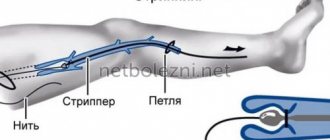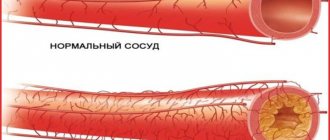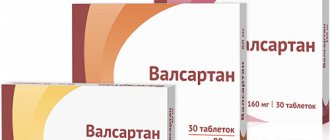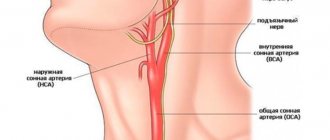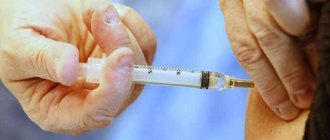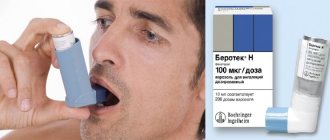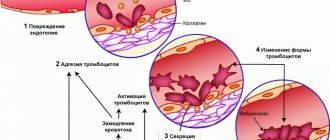Patients who are prescribed a drug therapy regimen are often interested in: what are angioprotectors? This is a special pharmacological group of drugs that has a positive effect on the functional state of the vascular wall and helps normalize microcirculation.
An angioprotective agent has the ability to normalize blood flow even in the smallest blood vessels, restore their tone, normalize metabolism and eliminate swelling.
It is worth noting that the pharmacological effect of drugs from the angioprotector group has not been fully studied to date. Each of the drugs that is included in this broad group has a different effect: due to the inhibition of hyaluronic acid derivatives or the provision of an anti-bradykinin effect.
Mechanism of action
Angioprotectors are medications whose essence is to correct blood microcirculation and regenerate the vascular wall. The mechanism of their influence on arteries and veins includes three stages:
- anesthesia;
- relief of inflammation at all stages of the pathological process;
- bradykinin blockade: suppression of vascular endothelial pastiness, prevention of rupture of interendothelial gaps preceding atherosclerotic changes.
Angioprotectors and microcirculation correctors slow down the synthesis of hyaluronidase and prostaglandins. This process has not been studied in detail, since there are many drugs that are combined in this group, and their effect on the elements of the bloodstream is different. The main properties exhibited by angioprotectors:
- increased antispasmodic activity, expansion of the lumen of blood vessels, improvement of microcirculation;
- correction of the rheological properties of blood with the prevention of thrombosis;
- reducing capillary fragility;
- normalization of metabolism in smooth muscles;
- balancing vascular tone, capillary wall permeability with simultaneous activation of the processes of diffusion, filtration, reabsorption, relief of edema, stagnation phenomena;
- prevention of oxidative stress.
How do these medications work?
Many patients suffering from similar problems are interested in what angioprotectors give and what they are. They are used for damage to the coronary arteries and blood vessels of the legs. Also, drugs in this group are used to eliminate inflammatory and stagnant processes, such as trophic ulcers or varicose veins. Strengthen capillaries and blood vessels with drugs such as glucocorticoids, ascorbic acid, rutin and others.
The mechanism of action of these drugs is not fully understood. But it is known that they restore blood composition and improve microcirculation. As a result, swelling is eliminated, blood vessels dilate, their tone and metabolism increase.
Before you learn about angioprotectors, what they are and so on, you should find out the pharmacological effect of such drugs. The group of such medications includes many drugs that have different therapeutic effects:
- They have an anti-bradykinin effect.
- Serve as prostaglandin antagonists.
- Suppress the activity of derivatives of the enzyme hyaluronidase or suspend its biosynthesis.
- Reduce the adhesion of blood cells to vascular walls.
- Stimulates the production of mucopolysaccharides in capillaries.
- Suppress platelet aggregation.
- Increases the permeability of vessel walls.
So, angioprotectors: what are they? Such medications help suppress the main links in the pathogenesis of vascular pathologies: inflammatory reactions, endothelial dysfunction and oxidative stress.
Indications for use
The group of angioprotectors corrects many pathological conditions, which are based on impaired permeability of the vascular wall, changes in the rheological properties of blood, and an imbalance of metabolic processes.
Therefore, each subgroup of angioprotectors has its own indications for use, which can be found by carefully reading the instructions included with each individual drug. But there is also a generalized list of indications for treatment with drugs of this group:
- atherosclerotic disease, including obliterating endarteritis of the lower extremities due to metabolic disorders;
- diabetic angiopathy, threatening amputation without timely initiation of therapy;
- IHD: angina pectoris, cardialgia of various etiologies, heart failure, arterial hypertension, acute conditions caused by myocardial ischemia, cardiosclerosis, cardiomyopathies;
- cerebrovascular syndrome: from encephalopathy to stroke;
- hemorrhoidal disease;
- thrombosis, thrombophlebitis due to changes in blood viscosity;
- vascular calcification, loss of elasticity;
- vasculitis;
- aneurysms;
- disruption of regional blood flow in any zone;
- varicose veins, venous insufficiency;
- retinopathy;
- nephropathy.
It is not difficult to understand what angioprotectors are: the drugs of the group are united by the result of their action - the ability to reduce the load on vessels of any localization, restoring the structure of the walls of arteries and veins, elasticity, strength, eliminate destruction, stimulating regeneration processes in the body, and balance the functioning of the blood clotting system.
The group is large, but there are not many main representatives of each subgroup. The characteristics of drugs are based on their action, which is correlated with the therapeutic potential of the drugs. A list of the most common angioprotectors is given below.
The vasoprotective effect is
Vazaprostan is available in the form of lyophysiate, intended for the preparation of a solution for intravenous infusion. The drug is a hygroscopic white mass, packaged in glass ampoules of 10 pieces in a cardboard box.
- The main active ingredient of the drug is alprostadil 20 or 60 mcg, as well as auxiliary components.
Clinical and pharmacological group: prostaglandin E1 preparation.
Vazaprostan is produced in the form of a lyophilisate for the preparation of a solution for infusion: a hygroscopic white mass (in glass ampoules, 10 ampoules in a cardboard box and instructions for use of Vazaprostan).
One lyophilisate ampoule contains 20 mcg or 60 mcg of the active substance - alprostadil (clathrate complex with alfadex).
Excipients: alphadex (α-cyclodextrin), anhydrous lactose.
The cardiovascular system works non-stop. In this situation, each link of a single complex needs a continuous supply of nutrients, energy resources, and protection from harmful compounds that enter the bloodstream.
The endings of the nerve fiber processes connect the vessels with the nervous system. When transmitting information in the form of a nerve impulse, the vessels spasm or dilate. The inner surface of the tubular formations produces components that stimulate blood microcirculation in order to provide biological fluid to the smallest vessels.
When capillary blood flow is disrupted - excessive or insufficient filling of capillaries with blood, tissue hypoxia develops. Angioprotectors are prescribed to eliminate vascular failures.
Pharmacological properties
- have antispasmodic activity;
- dilate blood vessels;
- enhance microcirculation in small vessels;
- improve the rheological properties of blood - prevent thrombosis;
- have a beneficial effect on the permeability of vascular walls - reduce the fragility and fragility of capillaries;
- inhibit the synthesis of hyaluronidase, which destroys the walls of blood vessels;
- activate exchange mechanisms (diffusion and filtration-reabsorption) in the vascular walls, thereby eliminating swelling and congestion;
- normalize vascular tone;
- prevent the development of oxidative stress.
There are three main stages that angioprotectors cope with: they relieve pain, relieve inflammation, and have an anti-bradykinin effect.
Pharmacodynamics
Vazaprostan is a prostaglandin E1 (PG E1) drug that has a vasoprotective effect. Thanks to the use of the drug, microcirculation and peripheral circulation improves. With systemic therapy, relaxation of smooth muscle fibers is observed.
Other effects of the active substance Vazaprostan - alprostadil include:
- Vasodilating effect, reducing total peripheral vascular resistance without changing blood pressure. In this case, there is a reflex increase in heart rate and cardiac output;
- Reducing the activity of neutrophils and platelet aggregation, increasing the elasticity of red blood cells, increasing the fibrinolytic activity of the blood;
- Suppression of gastric juice secretion;
- Stimulating effect on the smooth muscles of the bladder, intestines, and uterus.
Pharmacokinetics
Alprostadil is used in combination with alphacyclodextrin (intravenous or intra-arterial). When preparing the solution, the complex breaks down into individual components - PG E1 and alphacyclodextrin.
The therapeutically significant concentration of the active substance when administered intravenously is achieved soon after the start of administration, and Cmax (maximum concentration) in the blood plasma within 2 hours.
The binding of PG E1 to plasma proteins is 93%.
Metabolism of PG E1 occurs predominantly in the lungs; during the first passage through the lungs, about 60–90% of the active substance is metabolized, resulting in the formation of the main metabolites - 15-keto-PG E0, 15-keto-PG E1 and PG E0.
PG E1 is an endogenous substance that is characterized by an exceptionally short T1/2 (half-life). Plasma concentration in the blood returns to its original level 10 seconds after cessation of administration. It is excreted in the urine and through the gastrointestinal tract (at the level of 88 and 12%, respectively) within 72 hours in the form of metabolites.
T1/2 of alphacyclodextrin is approximately 7 minutes, excreted unchanged in the urine.
Vazaprostan, instructions for use: method and dosage
The solution is prepared immediately before the infusion. The use of a solution prepared more than 12 hours ago is not allowed.
For intra-arterial administration, the contents of the ampoule (20 mcg of alprostadil) are dissolved in 50 ml of physiological solution.
Unless otherwise prescribed, 10 mcg of alprostadil (half an ampoule) is administered intra-arterially over 60 to 120 minutes using an infusion device. If necessary, especially in the presence of necrosis, the dose can be increased to 20 mcg of alprostadil (under strict tolerance control). This dose is usually used for a single daily infusion.
If intra-arterial administration of Vazaprostan is carried out through an installed catheter, depending on the severity of the disease and tolerability, a dose of 0.1-0.6 ng/kg per minute is recommended with the drug administered over 12 hours when using an infusion device.
For intravenous administration, 40 mcg of alprostadil (2 ampoules of 20 mcg each) are diluted in 50-250 ml of saline and administered intravenously over 2 hours 2 times a day or 60 mcg of alprostadil (3 ampoules of 20 mcg each) over 3 hours once a day. day.
The average duration of therapy is 2 weeks. In the absence of positive dynamics, treatment is stopped; if improvement occurs, therapy can be extended for another 7-14 days.
In patients with renal failure (serum creatinine more than 1.5 mg/dl), intravenous administration of Vazaprostan should begin with 20 mcg (1 ampoule of 20 mcg) for 2 hours. If necessary, after 2-3 days the single dose can be increased to 40-60 mcg.
For patients with heart and kidney failure, the maximum volume of fluid administered is 50-100 ml per day. Duration of therapy is 4 weeks.
Main symptoms: decreased blood pressure, increased heart rate, vasovagal reactions may develop (manifested in the form of increased sweating, pale skin, nausea, vomiting); this may be accompanied by symptoms of heart failure and myocardial ischemia; Swelling, redness of the tissue, and pain at the infusion site may also occur.
Therapy: reducing the dose of Vazaprostan or stopping the infusion. If there is a marked decrease in blood pressure, the patient is transferred to a lying position with legs elevated. If symptoms persist, sympathomimetics are prescribed.
The approximate price for Vazaprostan (10 ampoules of 20 mcg each) is 8199–9834 rubles.
According to the instructions for use, Vazaprostan solution must be prepared immediately before administration into the bloodstream. It is absolutely unacceptable to store the solution until the next infusion.
- Intra-arterial administration. For intra-arterial administration, the contents of the ampoule (20 mcg of alprostadil) are dissolved in 50 ml of physiological solution. Unless otherwise prescribed, 10 mcg of alprostadil (half an ampoule) is administered intra-arterially over 60 to 120 minutes using an infusion device. If necessary, especially in the presence of necrosis, the dose can be increased to 20 mcg of alprostadil (under strict tolerance control). This dose is usually used for a single daily infusion. If intra-arterial administration of Vazaprostan is carried out through an installed catheter, depending on the severity of the disease and tolerability, a dose of 0.1-0.6 ng/kg per minute is recommended with the drug administered over 12 hours when using an infusion device.
- Intravenous administration. Lyophilisate for preparing a solution for infusion: 1 amp./20 mcg of alprostadil To obtain a solution for intravenous administration, the contents of 2 ampoules of lyophilisate (corresponding to 40 mcg of alprostadil) should be dissolved in 50-250 ml of physiological solution and the resulting solution should be administered intravenously for 2 hours. This dose is applied 2 times a day. Or the contents of 3 ampoules (corresponding to 60 mcg of alprostadil) are dissolved in 50-250 ml of physiological solution and administered intravenously for 3 hours 1 time per day.
DETAILS: Dogwood for hemorrhoids: how it works, reviews
According to the instructions, the average duration of drug therapy is at least 2 weeks. If the effect is insufficient or the patient’s condition is advanced, therapy can be extended for another 1-2 weeks as directed by the doctor. Patients with renal and heart failure require individual dose adjustment.
Symptoms of a drug overdose include decreased blood pressure, skin flushing, and general weakness of the body. In infants - bradycardia and apnea. Treatment involves slowing down or stopping the infusion (especially Vazaprostan 60). When observing the first signs of depressed breathing in infants, mechanical ventilation is recommended.
Adverse reactions
According to the instructions for Vazaprostan, its use can cause the following side effects:
- Allergic reactions: itching and skin rash; From the musculoskeletal system: reversible hyperostosis of tubular bones (with a duration of treatment of more than 4 weeks);
- Laboratory indicators: leukopenia, leukocytosis, increased titer of C-reactive protein;
- Local symptoms: phlebitis;
- From the nervous system: fatigue, headaches, malaise, dizziness;
- From the cardiovascular system: tachycardia, AV block, cardialgia, decreased blood pressure, development or worsening of heart failure, acute pulmonary edema, heart rhythm disturbances;
- From the digestive system: discomfort in the epigastric region, increased activity of “liver” transaminases, nausea and vomiting, hyperbilirubinemia (very rarely), diarrhea;
- In newborns: diarrhea, decreased blood pressure, hyperthermia, tachycardia, convulsions, hyperemia of the skin, depression of respiratory function (up to apnea), bradycardia, disseminated intravascular coagulopathy, skin rashes;
- Other: hyperthermia, increased sweating, swelling of the limb into which the infusion was made;
special instructions
Vazaprostan can only be used by doctors who have experience in angiology and are familiar with the methods of modern continuous monitoring of the cardiovascular system, as well as having the necessary equipment for this.
During therapy, it is important to monitor blood pressure, biochemical blood parameters, heart rate, blood clotting indicators (if disorders of the blood coagulation system occur or when used simultaneously with drugs that affect the coagulation system).
DETAILS: Sanorin - instructions for use, doses, indications
To avoid the appearance of symptoms of overhydration in patients with renal failure, the volume of fluid administered should be limited to 50-100 ml per day.
Dynamic monitoring of the patient's condition should be carried out (monitoring blood pressure and heart rate), if necessary, monitoring fluid balance, body weight, conducting an echocardiographic study or measuring central venous pressure.
Patients with coronary heart disease, impaired renal function and peripheral edema (serum creatinine more than 1.5 mg/dl) during the use of Vazaprostan and for 1 day after cessation of therapy should be in the hospital under the supervision of a physician.
As a rule, phlebitis (proximal to the injection site) is not a reason to stop treatment; symptoms of inflammation disappear within a few hours after changing the injection site or stopping the infusion. Specific treatment is not carried out in such cases. Central vein catheterization can reduce the incidence of this side effect of Vazaprostan.
Vazaprostan may affect the ability to operate machinery and drive vehicles during the period of initiation of treatment, increasing dosage and discontinuation of the drug, as well as when taking alcohol.
Drug interactions
- Antihypertensive and antianginal drugs, peripheral vasodilators: their effect is enhanced;
- Epinephrine (adrenaline), norepinephrine (norepinephrine): the vasodilating effect decreases;
- Anticoagulants, platelet aggregation inhibitors, cefamandole, cefoperazone, cefotetan, thrombolytics: the likelihood of bleeding increases.
It should be taken into account that an interaction may develop if the drugs listed above were used shortly before starting therapy with Vazaprostan.
It is prohibited to drink alcohol-containing drinks during the course of treatment with Vazaprostan.
When used in combination, the drug Vazaprostan can enhance the hypotensive effect of antianginal and antihypertensive drugs, peripheral vasodilators. When Vazaprostan is used simultaneously with antiplatelet agents, anticoagulants, cefamandole, thrombolytics, cefotetan, cefoperazone, the risk of bleeding increases.
In case of simultaneous use of Vazaprostan with norepinephrine or epinephrine, the vasodilating effect is reduced. It should be borne in mind that such an interaction may occur if the above drugs were used shortly before the introduction of Vazaprostan.
Analogs
Among the analogues of the drug Vazaprostan are:
- Alprostan (from 600.00 rubles);
- Caverject (from RUB 698.00);
- VAP 20 (from RUB 3,402.00);
- Alprostan Zentiva.
Attention: the use of analogues must be agreed with the attending physician.
Analogues of Vazaprostan are: VAP 20, Vasostenon, Muse, Alprostadil, Alprostan, Caverject, Edex, etc.
Classification of drugs
It is difficult to classify angioprotectors. There are several approaches to their gradation. The simplest one is in the form of release: tablets, suppositories, creams, gels, ointments for topical use. The second division is the method of application: external or for oral administration.
Angioprotectors can be divided into three large groups based on the origin of the drugs: herbal, semi-synthetic and synthetic.
There is a classification based on diseases that can be treated with tablet drugs:
- Antiplatelet agents, anticoagulants - drugs that correct blood viscosity, lyse blood clots in diseases of various origins that have a chronic course, make up the first group (Heparin, Aspirin, Cardiomagnyl).
- Thrombolytics are drugs with a similar mechanism of action, but for acute conditions: pulmonary embolism, heart attack, stroke - the second (Streptokinase, Urokinase).
- Drugs for normalizing microcirculation, correcting vascular lesions in diabetes mellitus, retinopathy, atherosclerosis (Pentoxifylline and its analogues, prostaglandins) are the third group of drugs.
- Phlebotonics, which eliminate damage to the venous bed, restore the function of venous valves (Detralex) are the fourth group of angioprotective agents.
- Vasodilators that reduce the load on the walls of blood vessels by expanding their lumen are the fifth group of drugs (Tivomax).
- Metabolic drugs that improve metabolism and blood circulation in different areas of the human body are the sixth group of drugs with angioprotective properties (Actovegin).
- Drugs that are used to treat retinal vascular pathology (Emoxipine) are a separate seventh group of drugs.
Angioprotectors can be divided into mono-drugs and multi-component drugs. In any case, the purpose of prescribing drugs in this group is to eliminate vascular disorders of various types.
Features of the use of angioprotectors
These drugs are prescribed for the treatment of vascular lesions that occur with widespread atherosclerosis, rheumatological pathologies or diabetes mellitus. Most often, vitamin-based medications are used for such diseases. Their mechanism of action is not fully understood, but it is believed that they suppress the production of hyaluronidase. It is this enzyme that is found in every focus of inflammation. This class of drugs helps eliminate edema and reduce the permeability of vascular walls.
If blood circulation is impaired in the peripheral bloodstream, angioprotectors are used to help increase the resistance of surrounding tissues to lack of oxygen. Even in this case, antioxidants are prescribed to suppress the formation of free radicals. The most common of these are vitamins E and C.
But when veins are damaged, vasodilators, antithrombotic and venotonic drugs are used. To treat such problems, it is recommended to use medications based on horse chestnut extract.
Angioprotectors are used to eliminate the consequences of coronary heart disease and cerebrovascular accidents. They make it possible to reduce the affected area near the blocked vessel and increase the resistance of cells to a lack of oxygen.
To treat blockage of the vascular lumen, which occurs due to changes in the composition of the blood or atherosclerotic plaques, antiplatelet drugs are used to prevent cell adhesion and the formation of blood clots. Moreover, antispasmodic medications that affect cholesterol are used.
Thrombolytics
Medicines dissolve already formed blood clots or fibrin strands that can transform into a blood clot. Used only in emergency cases: pulmonary embolism, acute myocardial infarction, stroke, thrombosis of the heart chambers.
There are drugs of several generations. The first is represented by Urokinase (1500 rubles), Streptokinase (1050 rubles). The second is Alteplase (Actilyse - 15,000 rubles), the third is Tenecteplase (25,000 rubles), Purolaza (8,500 rubles).
Are there any contraindications?
Contraindications must be considered for each drug. More modern means take into account the possibility of application and complications. The most significant include:
- childhood and adolescence;
- allergic reactions to the drug;
- period of pregnancy and breastfeeding;
- diseases of the stomach and intestines.
The use of external forms in the form of ointments, gels and creams is not indicated in the presence of skin diseases or non-healing ulcers.
Preparations for normalizing microcirculation
This includes drugs that can influence the blood viscosity system and stimulate blood flow with vasodilator properties, as well as substances that relieve inflammation with automatic expansion of the lumen of the capillaries - prostaglandins. Trental is considered the most popular.
Pentoxifylline and drug analogues
The essence of the angioprotective action of Pentoxifylline is the regeneration of vessels damaged by atherosclerosis or inflammation, improvement of blood viscosity, microcirculation due to the indirect expansion of the lumen of the capillaries. There are tablets (251 rubles) or ampoules (45 rubles).
- Trental (Flexital). This is a complete analogue of Pentoxifylline, prescribed for encephalopathies of various etiologies, ischemic stroke, vascular problems, in ENT practice. Price – 150 rubles.
- Vazonite. A long-acting drug thins the blood, balances microcirculation, but is able to correct coronary blood flow and relieve tissue hypoxia. Price – 379 rubles.
- Latrain. A medicine with the widest spectrum of action, applicable for all types of trophic disorders. The angioprotector is prescribed as part of complex therapy for ulcerative tissue lesions, gangrene, frostbite, varicose veins, and is used for diabetic polyneuropathy, angiopathy, and in the recovery period of ischemic stroke. Price – 215 rubles.
- Agapurin. A high-quality drug that is prescribed to patients with rheumatism, ENT pathologies, bronchial asthma, for the prevention of blood clots in the lower extremities. Allowed for pregnant women. Cost – 187 rubles.
Prostaglandins
All drugs relieve inflammation, resolve blood clots, lower blood pressure, and stimulate vascular tone through smooth muscles:
- Enzaprost-F – 4,500 rubles;
- Misoprostol – 1,100 rubles;
- Alprostan – 6,000 rubles.
Angioprotectors for external use
When treating veins, external remedies are often in demand. They are the drugs of choice when clients visit a pharmacy. Popular external angioprotectors are:
- Hepatrombin. It has an anti-edematous effect, removing excess stress from the legs. There is a form for rectal use that helps eliminate the symptoms of hemorrhoids;
- Lyoton. Available in the form of a gel in different volumes. It contains heparin, which is known for its absorbable properties. Due to this, swelling of the legs decreases, fatigue and heaviness disappear. Allowed during pregnancy, as it does not have a general effect on the body;
- Indovazin. A complex drug containing an anti-inflammatory component - indomethacin, as well as a venotonic - troxerutin. Thanks to the combined action, the drug relieves pain and burning in the legs. Prevents the formation of edema and cramps. Improves elasticity and blood circulation in blood vessels.
- Essaven gel. Used for varicose veins at different stages, and also as a preventive measure. It is acceptable to use the gel for hemorrhoids and prostatitis. Has a fast, local anti-edematous effect. After stopping use, it does not leave a long-lasting effect.
This list of external angioprotectors is constantly being supplemented with drugs.
Ointments and gels do not leave a long-lasting effect, but they help safely eliminate swelling, leaving virtually no side effects. External treatment of varicose veins is often not enough, so it would be more correct to use an integrated approach, combining external procedures with pill therapy.
Angioprotectors can support the health of people with various vascular diseases, but it is necessary to show patience and diligence during treatment. An integrated approach to treatment will eliminate problems with blood vessels or protect the body from possible heart problems.
Phlebotonics
A group of angioprotectors that tone the valvular apparatus of the veins, improve venous blood flow, and relieve congestion. Used to treat hemorrhoids and varicose veins. By normalizing blood circulation in the corresponding area, inflammation is relieved, the vessels automatically dilate (pastiness due to exudation disappears), and elasticity is restored. The most common is Detralex.
- Detralex. An angioprotector that stimulates the tone of venous valves, improves the elasticity of vascular walls, has an effect when taken as a course, and does not affect the blood clotting system. Prescribed for vascular congestion in any area. Price – 640 rubles.
- Venarus. Structural analogue of Detralex of domestic production. Cost – 490 rubles.
- Phlebodia 600. Angioprotector with venotonic properties, restores the vascular wall, relieves inflammation, venous congestion, improves microcirculation. Price – 850 rubles.
- Vasocket. Vasoket tablets are based on flavonoids with angioprotective, restoring the structure of the vascular wall, and anti-inflammatory properties. Cost – 600 rubles.
- Antistax. Angioprotector, belongs to the group of herbal phlebotonics. Natural components provide a mild effect: relieves pastiness, stimulates local immunity, improves vascular permeability. Price – 580 rubles.
Drugs used for varicose veins
For varicose veins affecting the veins of the lower extremities, herbal preparations obtained from the leaves, fruits and bark of horse chestnut . These products contain biologically active compounds - escin, saponins, flavonoids and others. These substances reduce the permeability of the walls of capillaries and small veins for fluid, as a result of which the exudation (sweating) of water from the vessels into the tissue is suppressed. At the same time, swelling decreases and the strength of the vascular walls increases. The most commonly prescribed drugs are:
- escin (aescin, venastat, venitan, concentrin, reparil, cycloven forte);
- aescusan (venoplant);
- esflazide.
These drugs are used for any form of chronic venous insufficiency (varicose veins of the lower extremities, pelvis, hemorrhoids), as well as for injuries of the extremities to reduce swelling. They are prescribed in the form of tablets, drops for oral administration, cream or gel for external use. There are also solutions for parenteral administration, prescribed primarily for the treatment of cerebral edema.
When taken orally, side effects may develop - feelings of fever, nausea or vomiting, allergic reactions. Skin irritation is possible when used topically.
Preparations based on horse chestnut are contraindicated in the first trimester of pregnancy, during breastfeeding, and also in case of renal failure. Please note that the drops contain ethanol, so they should be taken with caution.
Tribenoside (glivenol, tribenol) increases the tone of veins, normalizes microcirculation, and reduces the permeability of the walls of small vessels. It is an antagonist of bradykinin and serotonin, which cause swelling and damage to the inner lining of blood vessels - the endothelium. This medicine is prescribed for venous congestion caused by varicose veins, phlebitis, and hemorrhoids. Side effects - nausea, abdominal pain, itching. The drug is not prescribed in the first trimester of pregnancy.
Means for increasing the lumen of arteries
The mechanism of action of this group of angioprotectors is based on the ability to expand the lumen of blood vessels, reducing the load on arteries and capillaries, thereby normalizing blood flow to a certain area. These are nitro group donors. There are two drugs on the pharmacological market: Tivomax, Tivortin.
The active ingredient of Tivomax is the amino acid arginine chloride. Refers to blood replacement solutions, available in bottles with a solution for infusion. The drug exhibits protective effects that are important in a critical condition of the body. Prescribed for atherosclerosis, diabetic angiopathy, angina pectoris, CHF, hypertension. Price – 135 rubles through online pharmacies.
A structural analogue of Tivomax is Tivortin. Price – 214 rubles through online pharmacies.
Classification
Angioprotective drugs are divided into several areas:
- By form of origin (synthetic and natural plant);
- According to their composition of components (single drugs - this is troxerutin and several components in a combined drug - this is Detralex, the drug Indovazin).
Herbal natural preparations are much safer than their synthetic counterparts and cause fewer problems.
By pharmacological types and generations
| Generation No. | vasoprotectors generation No. 1 | generation No. 2 | ||
| drugs | Angioprotector Pentoxifylline | tablets | injections | · Prostaglandin (alprostadil) injection only; |
| Angioprotective drug Pentilin | pills | injections | ||
| angioprotective drug Trental | tablets | injections | · Vazaprostan - tablets, injections; | |
| · Alprostan - tablets, injections. | ||||
| Vasoprotector Vazonit | tablets | · Ilomedin - tablets and injections; | ||
Classification of angioprotectors by pharmacological types
Metabolic drugs
Angioprotectors, which are part of the group of metabolics, have a complex effect on the human body, including a positive effect on blood flow, the condition of blood vessels, metabolism, stimulate the utilization of glucose, increase the energy reserves of cells, and prevent ischemia and hypoxia. Prescribed for all forms of coronary artery disease, encephalopathies, vascular and metabolic disorders. The most famous is Actovegin.
- Actovegin. The drug is an antioxidant, antihypoxant with a metabolic, neuroprotective, microcirculatory effect. Indicated for circulatory disorders, including peripheral, cognitive disorders, diabetic polyneuropathy. Price – 569 rubles.
- Glycine. Angioprotector with metabolic properties, has antidepressant and sedative effects. Price – 30 rubles.
- Inosine (Isoprinosine). An ATP precursor drug with antihypoxic, metabolic and antiarrhythmic effects. Increases the energy balance of the myocardium, improves coronary circulation, and is applicable for all types of coronary artery disease. Cost – 604 rubles.
Angioprotectors - list of drugs
The most popular and effective angioprotectors are those that have the proper therapeutic effect, produced in the form of tablets and capsules orally:
- Vasocket.
- Detralex.
- Phlebodia 600.
- Aescusan.
- Ascorutin.
- Venoruton.
- Pentoxifylline.
- Troxevasin.
- Venarus.
This list is supplemented by angioprotectors that have the appropriate pharmacological effect for external treatment of diseases.
Angioprotectors as ointment, gel and cream for external use:
- Heparin.
- Procto-Glivenol.
- Hepatrombin.
- Proctosan.
- Venitan.
- Lyoton gel.
- Venorutinol.
- Proctosedyl.
- Essaven.
- Troxevasin.
For oral administration
Many angioprotectors are prepared by pharmacists as tablets or capsules for internal use.
The most popular and effective:
- "Detralex." Protects blood vessels and increases the tone of the vascular walls. Helps stimulate lymphatic drainage, improve microcirculation, and eliminate signs of inflammatory processes. Eliminates the activation, movement and adhesion of white blood cells at the capillary level. After a short use of this remedy, most patients may notice a decrease in the severity of symptoms of pathological processes: pain, swelling, heaviness of the legs. In this regard, the degree of psycho-emotional and physical comfort in patients increases. The product is used both for medicinal purposes and for prevention. If necessary, it is also prescribed during pregnancy.
- "Phlebodia". A drug that belongs to the subgroup of angioprotectors. Helps strengthen and protect blood vessels, increase the strength and overall resistance of capillaries, is characterized by an anti-inflammatory effect and increases blood supply to the skin. The drug is prescribed to patients with various forms of venous insufficiency (hemorrhoids). It copes effectively during exacerbations of the disease and can give excellent results: the main symptoms will disappear, the bumps will decrease, itching, burning, pain and other unfavorable symptoms will disappear.
- "Eskuzan." A medication that has an antioxidant effect, reduces swelling and inhibits the exudation process, which tones the veins. Horse chestnut extract, which is included in the product, helps stimulate the production of hormones by the adrenal cortex and the biosynthesis of prostaglandins. Normalizes the activity of contractions of smooth muscle fibers, reduces vascular fragility, and helps improve metabolism within tissues.
- "Ascorutin". A complex of vitamins for blood vessels, which participates in oxidation and reduction reactions and replenishes the lack of vitamins C and P within the body. Helps strengthen the walls of blood vessels, reduce their permeability and fragility. The drug is involved in strengthening capillaries and the immune system.
- "Venoruton". It is characterized by angioprotective and phlebotonic effects. Intended to eliminate microcirculation failures and regenerate the functioning of the vascular endothelium. The product has minor anti-inflammatory and antioxidant effects and helps inhibit the activity of inflammatory mediators. The rheological parameters of the blood become better , the aggregation of red blood cells decreases and their structure returns to normal. The drug is used by patients with trophic ulcers of the extremities, thrombophlebitis, varicose veins, and hemorrhoids.
- "Troxevasin". A herbal medicine that normalizes capillary permeability and reduces signs of inflammatory processes. Helps eliminate pain, swelling and heaviness of the legs. Thanks to the main active component , it provides a strong antioxidant effect, helps tonify and strengthen vascular walls, and eliminates trophic disorders.
- "Pentoxifylline." Restores microcirculation, has an anti-aggregation effect and reduces calcium content inside cells. In addition to tablets, it is available in the form of injections. Prescribed during failures in peripheral and cerebral circulation, tissue degeneration, oxygen starvation of the retina.
For external use
Local therapy for vascular diseases consists of the use of medications that are available as ointments, gels and creams.
The best angioprotectors for these purposes:
- "Hepatrombin." Combined product for external use. Prevents the formation of blood clots, promotes regeneration, relieves swelling of the legs and has a good anticoagulant effect. The drug inhibits blood coagulation and stops the formation of blood clots. Helps eliminate hemorrhoids, improves blood supply to areas of inflammatory processes and participates in the restoration of connective tissue.
- "Lyoton." An effective remedy that was created to counteract swelling and heaviness of the legs during the period of venous insufficiency. It is produced in the form of gels that quickly and easily penetrate the target. Removes fatigue and helps eliminate pain. The anti-inflammatory effect of the drug is due to a decrease in hyaluronidase activity directly at the site of the inflammatory process. Accelerates the elimination of hematomas and blood clots, reduces swelling.
- "Indovazin." Combination medicine
which is produced in the form of gels. It contains 2 main components: troxerutin and indomethacin, which give an anti-inflammatory and angioprotective effect. Removes swelling, reduces pain and other signs of inflammatory processes, increases blood circulation. Reduces fragility and helps reduce capillary permeability, tones veins, quickly removes bruises, reduces local hyperthermia and pain at the site of inflammation. - "Essavan-gel". An angioprotective agent that is used during the period of venous inflammation and enlargement, swelling of the legs, bruises and sprains. Helps slow down the subsequent progression of venous insufficiency, promotes the resorption of hematomas, and reduces swelling.
Drugs for the treatment of retinal vascular pathology
This is a separate group of special agents that improve the condition of the retinal vessels, normalizing its blood supply and oxygen supply:
- Emoxipine - normalizes the permeability of the vascular wall, demonstrates the properties of an antihypoxant, antioxidant, improves the rheological properties of blood (211 rubles);
- Etamzilate (Ditsinon) – an antihemorrhagic agent that improves microcirculation (37 rubles);
- Divaskan - reduces increased vascular permeability (1350 rubles).
Necessary and useful angioprotectors - drugs for blood vessels and veins
In complex treatment regimens for heart and vascular diseases, a group of medications called angioprotectors is used. The Russian classification combines them with microcirculation correctors.
They have the ability to restore wall tone and blood flow in the vascular bed, and normalize blood fluidity.
Such drugs are prescribed for various angiopathy, atherosclerosis, and autoimmune diseases.
Pharmacological action of angioprotectors
These drugs have completely different chemical structures and mechanisms of action, but they are united by common pharmacological properties and the end result - improved blood flow through the arteries and veins. The effect of angioprotectors on blood vessels is manifested as follows:
- arteries dilate;
- the vascular wall is strengthened;
- metabolism in smooth muscle fibers is normalized;
- the inflammatory process in the inner membrane is relieved;
- the ability of platelets to stick together (aggregation) and attach to the wall (adhesion) decreases;
- prevent collagen destruction;
- spasmodic vessels relax;
- microcirculation improves;
- restore normal permeability.
We recommend reading the article about strengthening the blood vessels of the lower extremities. From it you will learn about the reasons for the development of varicose veins, the provision of medical assistance, and the effectiveness of diet.
And here is more information about the prevention of vascular thrombosis.
Classification of drugs
All angioprotectors are divided into groups depending on the diseases for which they can be used.
The first group contains medications for hemorrhoids and anal fissures. It combines (in addition to vascular drugs) hormones, painkillers and anti-inflammatory drugs. They are all used exclusively for local treatment, so the release form can be gel, ointment or suppositories. Popular trade names: Relief, Proctosedyl M, Ultraproct, Anuzol.
The second group is no less extensive; it also includes only external forms of medicinal substances for the treatment of varicose veins of the lower extremities. Most of them contain heparin as the sole active ingredient or in combination with other ingredients. Names of ointments or gels:
- Lyoton 1000,
- Heparoid,
- Lavenum,
- Trombless,
- Hepatrombin,
- Venitan.
In addition to heparin, sodium pentosan is included in the composition of drugs for the treatment of dilated veins of the extremities. The drug is called Thrombocide.
Also, with varicose veins, good results are obtained from the injection of sclerosing substances into the vein. They are able to freeze and block the lumen of the vessel, cutting it off from the blood flow. These are medications such as Sclerovane, Fibro-Vein.
For internal use, a broad group called capillary stabilizing agents is used. Essentially, they can not only affect an already formed thrombus or narrowed vessel, but also perform the main function of protecting the vascular wall. These include bioflavonoids (venotonics) and other microcirculation correctors.
Watch the video about the use of angioprotectors and their action:
Venotonics or venous angioprotectors
The group of bioflavonoids are preparations created on the basis of natural ingredients. These include such effective compounds and drugs as:
- rutoside (Venoruton, Ascorutin),
- diosmin (Phlebodia, Detralex),
- troxerutin (Troxevasin, Ginkor fort),
- hydrosmin (Venosmil).
Their mechanism of action on veins is based on reducing vascular permeability, strengthening the wall, reducing platelet aggregation, eliminating pain and swelling in varicose veins.
In addition to bioflavonoids, other capillary-stabilizing medications have been identified. They are produced both on the basis of natural ingredients and obtained chemically. They share similar pharmacological effects:
- increased venous tone,
- protection of the vascular wall from destruction,
- reduction of tissue swelling and inflammation,
- decreased capillary fragility,
- elimination of venous stagnation.
Drugs included in this group: Aescusan, Cyclo-3-fort, Corvitin, Emoxipin and Quercetin, Aescin, L-lysine aescinate.
The best and modern angioprotectors
Drugs for the treatment of venous insufficiency and angiopathy are prescribed only by a doctor, since despite the many general effects of their use, these drugs also have individual characteristics.
If the patient is faced with a choice: which medicine is better to buy - the original or the generic, then in this case it is preferable to take at least the first course of a more active drug, and analogues can be used for maintenance therapy. The original and most effective angioprotectors include: Detralex, Cyclo-3-fort and Ginkor fort.
Detralex
It consists of two flavonoids - diosmin and hesperidin. The advantage of Detralex is its original production technology - a microionized form of the active ingredients.
Many doctors and patients note its high effectiveness for hemorrhoids and varicose veins of the lower extremities. It quite quickly relieves heaviness in the legs and swelling, relieves pain and night cramps in the legs. Helps heal trophic ulcers, eliminate inflammation and bleeding during exacerbation of hemorrhoidal disease.
Cyclo-3-fort
Due to its direct effect on the vascular wall, the drug increases venous tone, and also has the property of activating the flow of lymphatic fluid and reducing the fragility of capillaries.
It is prescribed not only for the treatment of varicose veins and hemorrhoids, but also for the resolution of postoperative edema, reduction of uterine bleeding associated with high levels of progesterone in the blood, and chronic lymphatic insufficiency. The composition includes butcher's broom extract, vitamin C and hesperidin.
Ginkor fort
This medicine consists of heptaminol, troxerutin and extract from ginkgo biloba leaves. It has an antioxidant and analgesic effect in addition to capillary stabilizing. Used for the treatment of varicose veins and hemorrhoids, as well as in combination with other drugs for impaired cerebral blood flow.
Angioprotectors for the eyes
Damage to the vessels of the retina occurs with diabetes mellitus, hypertension, and atherosclerosis. This condition is called retinopathy, and it reflects a systemic process of damage to the walls of the veins and arteries of the body. Progressive retinopathy leads to vision loss. Therefore, treatment with angioprotectors is indicated at any stage of the disease.
Diabetic retinopathy - an indication for the use of angioprotectors
Emoxipine is considered the most effective drug. It reduces blood viscosity, accelerates the resorption of hemorrhages in the fundus, increases the resistance of brain cells to hypoxia, and protects the retina from destruction by laser or solar irradiation.
In addition to Emoxipine, for pathology of retinal vessels, Etamsylate (Dicynon), Trental, Divascan, Troxerutin, Calcium Dobesilate are prescribed.
Microcirculation correctors for external use
If varicose veins affect only superficial veins, then external treatment using ointment and gel forms of drugs is recommended. In the initial stage, this may be enough; in the future, local remedies are combined with the internal use of venotonics.
Lyoton 1000
It is a gel, 1 g of which contains 1000 IU of heparin. Once absorbed into the skin, it helps reduce swelling, inflammation, and increased blood clotting. Prescribed for varicose veins and its complications - phlebitis, thrombosis, after surgical treatment of blood vessels. It is also used for injuries and sprains, soft tissue bruises, and hematomas.
Troxevasin
The drug contains rutoside, a derivative of vitamin P. The main therapeutic effects are:
- tones and protects the venous wall,
- relieves inflammation and pain in the legs,
- inhibits the release of blood from vessels into tissues,
- prevents platelet fixation on the vessel wall.
Indicated for soft tissue injuries associated with injury or surgery to resolve swelling, improve venous and lymphatic outflow, thrombo- and periphlebitis, dermatitis with varicose veins.
Venitan
It is produced on the basis of extract from horse chestnut seeds.
It has an anti-inflammatory and tonic effect on the venous network, tightens the vascular walls, and prevents fluid from accumulating in the tissues in the form of edema.
Helps with night cramps, pain and heaviness in the legs, itching associated with venous insufficiency. Safe for pregnant women, used for injuries to muscles and ligaments in sports medicine.
Angioprotectors are prescribed to strengthen the vascular wall, improve blood circulation and tissue nutrition in case of venous insufficiency, inflammation or damage to blood vessels. They can be used topically or internally. Many drugs are based on plants, so patients report minimal side effects during treatment.
For optimal effect, it is recommended to use original medications for oral use and external agents.
Source: https://CardioBook.ru/angioprotektory-preparaty/
Contraindications
Restrictions on use are also individual, as are the indications for prescribing drugs in this group. But angioprotectors are generally well tolerated, so some data can be generalized across subgroups of agents.
Anticoagulants are not prescribed if there is a predisposition to bleeding, including hereditary nature.
Vasodilators, metabolic drugs, phlebotonics are not recommended for individual intolerance or sensitization of the body.
Drugs to improve microcirculation are contraindicated in:
- pathologies of the cardiovascular system;
- rehabilitation after hemorrhagic stroke;
- risk of bleeding;
- aged over 60.
Angioprotectors for oral administration
The often prescribed drugs in this group are the internal forms, which have the most complete therapeutic effect. The most famous are: Detralex, Venarus, Doxy-chem, Troxevasin, Troxerutin, Ascorutin, Ginkor Fort, Venoruton, Aescusan.
Detralex
An imported drug for the treatment of venous insufficiency, which is a powerful venotonic that has a positive effect in 95% of cases. It is prescribed for varicose veins, hemorrhoids, thrombophlebitis, and also as a preventive measure for varicose veins. It may take more than one month to achieve results.
Cyclo 3 fort
Reduces the fragility of blood vessels, strengthens the walls, increases the elasticity of veins. Thanks to its rich composition, it can have a lymphatic drainage effect. It is used in the field of phlebology and is also used in cases of edema after surgery. Able to reduce the risk of uterine bleeding due to hormonal deficiency.
Ginkor fort
A complex preparation containing troxerutin, gingko biloba and heptaminol. It is used for vein diseases, circulatory problems, and memory problems. This medicine helps reduce hypoxia and has antioxidant properties. Successfully fights the consequences of atherosclerosis.
Angioprotectors for the eyes
Retinopathy or angiopathy progresses rapidly, leaving a person without vision. The following can quickly restore vascular tone, as well as stop destructive processes in the retina of the eye: trental, troxerutin, emoxipin, divascan, dicinone. The drugs improve capillary permeability and deliver oxygen to the brain. Due to such effects, intraocular pressure disappears and vision improves.
Pentoxifylline
Produced by many manufacturers, including foreign ones. Improves blood circulation, relieves hypoxia. Helps thin the blood and strengthens the walls of blood vessels. In addition, pentoxifylline is a vasoprotector, reduces red blood cell aggregation and prevents the formation of blood clots. It is produced in the form of a solution for injection and tablets for oral administration. The solution has a faster effect during treatment. Pentoxifylline is often included in complex therapy.
Phlebodia
The main component is diosmin. Due to the high concentration of diosmin, it has a persistent venotonic effect. It is prescribed for a course of at least two months. During this time, accumulating in the body, the drug has time to open up and leaves behind a long therapeutic effect. For chronic venous insufficiency, Phlebodia is taken in two courses per year.
Aescusan
This is a herbal tincture based on horse chestnut. This component is used in the treatment of veins and cardiac pathologies. The liquid form is contraindicated for persons whose work requires quick reactions. It is worth considering that this remedy helps quickly, but the effect after treatment may quickly end.
Askorutin
A well-known vitamin remedy based on ascorbic acid and rutin. It has a weak venotonic effect and strengthens small capillaries. Actively used in pediatrics for nosebleeds. Helps tonify blood vessels during coughs, varicose veins, and diabetes.
Venoruton
This is an angioprotector of plant origin. Venoruton has a venotonic effect, relieves legs from heaviness, swelling and spider veins. Prevents thrombophlebitis, eliminates bumps on the legs. The only downside is the side effect on the stomach. When treating with this drug, you need to be careful and use stomach protection measures.
Troxevasin
Analogue of venoruton. Contains troxerutin and is similar in action to the drug above. It is an angioprotector and microcirculation corrector. The course of treatment with troxevasin is 1 month, subject to correct dosage (3 capsules per day after meals). It is used for diseases of veins and blood vessels of moderate severity. Can be used for hemorrhoids.
Attention! Do not take the medicine without consulting your doctor; unwanted reactions may occur.
Side effects
Negative consequences also vary from person to person and depend on the type of drug. With a high degree of probability we can talk about the development of the following side effects:
- anemia;
- hives;
- asthma attack;
- anaphylaxis to Quincke's edema;
- migraine;
- nosebleeds;
- tinnitus;
- rhinorrhea;
- dyspepsia;
- symptoms of intoxication;
- blood impurities in urine.
Fatal complications are extremely rare and develop due to the negligence of a doctor or patient: stroke, acute heart or kidney failure.
Side effects of angioprotectors
Side effects of angioprotectors:
- Headache;
- Dizziness may be so severe that it provokes nausea and vomiting;
- Fatigue of the body;
- General malaise;
- Discomfort in the stomach;
- Vomiting from the body;
- Severe diarrhea;
- A sharp decrease in blood pressure index, which provoked hypotension;
- Increased heart rate - tachycardia;
- Disturbance of rhythm in the work of the heart muscle - arrhythmia;
- Phlebitis at the injection site;
- Increased sweat production by the body;
- Pathology hyperthermia;
- Allergy to components;
- Development of bone hyperostosis - when taken for a long time.
Vomiting and diarrhea
Side effects when used in newborns:
- Pathology hyperthermia;
- A strong decrease in blood pressure—hypotension;
- Severe diarrhea;
- Rapid heartbeat - tachycardia;
- Slow heartbeat - bradycardia;
- The heart rhythm is disturbed - arrhythmia of the cardiac organ;
- Muscle tissue spasms;
- Labored breathing;
- DIC syndrome develops.
Also, side effects can occur when the drugs are taken incorrectly, or taken in the wrong dosage, which could cause a large accumulation of the active substance in the body and its intoxication occurs.
In case of overdose, it is necessary to rinse the stomach and take sorbents. Also monitor the intake of fluids in the body to maintain water balance and prevent dehydration. And immediately contact your doctor.
Literature
- Dedov, I.I. State register of diabetes mellitus in the Russian Federation: status in 2014 and development prospects / I.I. Dedov, M.V. Shestakova, O.K. Vikulova // Diabetes mellitus. – 2020. – No. 18(3).
- Egorov, E.A. The use of angioprotectors in the treatment of diabetic angiopathy: focus on calcium besylate / E.A. Egorov, Zh.G. Oganezova // Russian Medical Journal. – 2020. – No. 4.
- International Diabetes Federation. IDF Diabetes Atlas, 7th ed. Brussels: International Diabetes Federation, 2020.
- Yau JWY, Rogers SL, Kawasaki R. et al. Meta-Analysis for Eye Disease (META-EYE) Study Group. Global prevalence and majority risk factors of diabetic retinopathy // Diabetes Care. 2012.
- American Diabetes Association. Standards of medical care in diabetes: 2008 // Diabetes Care. 2008.
Lyudmila Zhavoronkova
Higher medical education. 30 years of working experience in practical medicine. More about the author
All articles by the author
Classification of angioprotectors
Due to the wide variety of drugs, it is possible to classify them in various areas:
By origin
- Preparations containing components of plant origin:
- horse chestnut fruit extract;
grape seed extract;
- vitamins C, P;
- glucocorticoids
Herbal preparations include:
- Coumarin;
- Aescusan;
- Troxevasin
The use of a combination of vitamins Ascorutin (C and P) helps strengthen the muscle tissue of the vascular wall, significantly reducing its capillary permeability, which helps reduce swelling. Find out more about Ascorutin - what kind of drug it is in our similar article.
- Calcium dobesilate;
By composition
Single-component preparations:
- Troxevasin
- Detralex
- Troxerutin;
- Lyoton
Combination drugs
Single-component preparations contain one active substance and its use is often combined with the use of an additional drug in order to provide a complex effect on the affected organ. The advantage of a single-component drug is the variability in the choice of combination of drugs to achieve the greatest effect in treatment, taking into account intolerance to one of the components. Combination drugs consist of a complex of active substances, the combination of which is aimed at treating a specific pathology.
By area of application
- Venous insufficiency:
- phlebeurysm;
haemorrhoids;
- metabolic disorders in tissues (trophic ulcers)
In the treatment of venous lesions, angioprotectors are used, which have antiplatelet, anti-inflammatory, vasodilating and tonic effects. The purpose of the treatment is to improve blood flow in the venous bed, improve venous tone, and normalize the functioning of venous valves. Intensification of metabolic processes in tissues helps overcome stagnation and accelerates the process of tissue regeneration in trophic ulcers. Drugs used for venous insufficiency:
- Detralex;
- Phlebodia;
- Aescusan
- In a similar article you will find even more information about the treatment of venous insufficiency of the lower extremities with drugs.
- rheumatoid arthritis;
spinal diseases
Due to the restoration of blood supply to the spine at the level of microcirculation, oxygen transport to damaged tissues increases, the elasticity of vascular walls is restored and the regeneration of nerve structures is restored. The best results are achieved in combination with steroidal or non-steroidal anti-inflammatory drugs.
- atherosclerosis;
cerebrovascular accident;
The purpose of using angioprotectors in the treatment of cerebrovascular accidents and cardiovascular diseases is to restore the required volume of oxygen delivered to the brain. Helps reduce the risk of blood clot formation due to rupture of an atherosclerotic plaque. In this case, the use of antiplatelet drugs is indicated to improve blood flow, as well as drugs that help lower cholesterol (drugs from the statin group) to reduce the concentration of low-density lipoproteins (LDL) in the blood. The use of combination therapy in the treatment of cardiovascular diseases can reduce the ischemic area, increase coronary reserve, thereby reducing the number of angina attacks.
- diabetic retinopathy;
diabetic nephropathy;
The use of angioprotectors in the treatment of diabetic vascular lesions makes it possible to achieve positive dynamics in reducing blood viscosity, erythrocyte aggregation, and erythrocyte elasticity. Helps improve blood circulation at macro and micro levels, promote regenerative processes in tissues. Drugs used to treat diabetic angiopathy:
- Pentoxifylline;
- Bilobit;
- Rutoside;
- Nicotinic acid (Vitamin PP)
Popular oral medications
Oral medications in the form of capsules and tablets are used for severe and chronic diseases. They need to be taken twice a day.
Effective medicines
| Name | a brief description of |
| Detralex | The tablets improve the condition of blood vessels, improve microcirculation, and eliminate the manifestations of inflammatory processes. With regular use, pain decreases, swelling and heaviness in the limbs disappear, and general condition improves. |
| Askorutin | The drug replenishes the deficiency of vitamins C, P, strengthens vascular walls, and reduces their permeability. The medicine helps strengthen the immune system. |
| Tanakan | A medicine for improving cerebral circulation based on ginkgo biloba. Prescribed for impaired coordination and hearing, attacks of dizziness, arteriopathy of the legs. |
| Phlebodia | Improves blood circulation, increases capillary resistance, eliminates inflammation. The medicine helps with varicose veins, acute hemorrhoids, and impaired microcirculation in the capillaries. |

